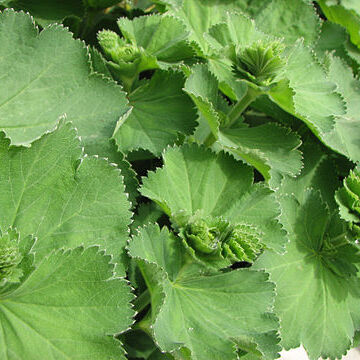Perennial or annual (but not in tropical East Africa) herbs or low shrubs. Stems woody or herbaceous, erect or decumbent, often arising from a central rosette producing extensively creeping or scrambling non-rooting runners or stolons rooting here and there at the nodes. Leaves radical or cauline or both on the one plant, sessile to long-stalked, undivided or divided into a varying number of shallow or deep lobes arranged palmately or flabellately within a rounded to reniform outline; petioles adnate in part or throughout to membranous or foliaceous stipules. Inflorescence simple or branched, racemose or paniculate, exceeding or ± hidden among the leaves, axillary, few-to many-flowered, sometimes congested. Flowers small, hermaphrodite, tetramerous, pedicellate to subsessile, subtended by a bract. Calyx-tube urceolate, ± membranous and persistent, bearing around the mouth two series each of 4 free lobes, the inner 4 (calyx-lobes) alternating with the usually smaller outer 4 (epicalyx-lobes); disc fleshy or somewhat so, closing the mouth of the calyx-tube. Petals 0. Stamens 4, inserted on the rim of the disc, alternate to the calyx-lobes. Carpels 1–12, stalked, inserted at the base of the receptacle; styles basal; stigma capitate. Achenes 1–12, included within the calyx-tube.
Perennial herbs, often prostrate or procumbent, often stoloniferous. Leaves alternate, petiolate, usually palmately lobate or cleft, the upper smaller, with fewer lobes or divisions, sessile; stipules sheathing, usually foliaceous, lobed or cleft, adnate to the petiole, the whole often appearing as a multifid perfoliate leaf or a many-lobed sheath. Flowers minute, usually crowded into small axillary or terminal glomerulose cymes, less often in loose racemoid inflorescences; hypanthium per-sistent, urceolate, the 8-10 lobes 2-seriate, the outer ones smaller; petals none; stamens 1-4, free, opposite the calyx-lobes, the filaments short, usually not more than half the length of the calyx-lobes; disk with thickened margin, nearly closing the mouth of the hypanthium. Fruit of 1-6 achenes, these sessile or stipitate, in-cluded in the hypanthium, with basal, ventral, ascending and persistent styles, and capitate or clavate stigmas.
Herbs perennial (rarely annual), with woody rhizome. Stems decumbent to erect. Leaves stipulate, long petiolate; stipules adnate to sheathing petiole; leaf blade simple, ± orbicular, margin lobed, digitate, or palmately parted. Inflorescences usually dense corymbs, rarely lax cymes or a solitary flower, ebracteate. Flowers very small, bisexual. Hypanthium urceolate, persistent, with constricted throat. Sepals 4(or 5), valvate; epicalyx segments 4(or 5), alternating with sepals. Petals absent. Disk lining hypanthium, margin thickened. Stamens (1–)4; filaments free, short. Carpel 1(–4), sessile or substipitate, free; ovule ascending from base of locule; style basal or adaxial, filiform, glabrous; stigma capitellate. Achene 1(–4), enclosed in membranous hypanthium. Seed basal; testa membranous; cotyledons cylindric-obovoid. x = 8.
Perennial or annual, erect or prostrate herbs or suffrutices. Leaves simple, usually petioled, ± orbicular in outline, palmately to pedately nerved and palmately incised, folded in bud. Stipules rather large. Flowers sometimes solitary, usually in cymes, corymbs, or racemes, small, 4-merous (more rarely 5-merous), bisexual. Hypanthium ± urceolate, throat almost closed by the disc. Epicalyx leaves usually smaller than sepals, rarely 0. Sepals valvate. Petals absent. Stamens 1, 2, or 4, rarely 5, inserted outside or inside the disc, epi-or alternisepalous, short, pollen in many species sterile (apogamy). Pistils 1-4 (-10), free; ovaries sessile or shortly stalked, 1-locular, style ventral or subbasal, protruding through the disc. Achenes 1-4, remaining enclosed in indurate hypanthium, pericarp bony to membranous.
Short-stemmed, perennial herbs; branches short; rhizomes woody. Lvs mostly basal, palmate or palmately lobed, usually dentate; stipules large and persistent. Infl. a compound cyme with fls aggregated into glomerules. Fls 4-(5)-merous, small, yellowish or greenish, shortly pedicellate, ☿. Hypanthium campanulate or urceolate. Epicalyx present, the lobes sometimes > calyx lobes. Calyx with ± triangular sepals. Petals 0. Stamens 4-(5), inserted on outer margin of hypanthium disc. Ovary superior, surrounded by the hypanthium; carpel 1; style 1; ovule 1. Fr. a single achene, wholly or partly enclosed in the thin, dry hypanthium.
Hypanthium ellipsoid to turbinate or campanulate, permanently enclosing the ovary or ovaries; sep mostly 4, spreading or ascending; bractlets sometimes present; pet none; stamens 4(5), inserted on the outer margin of the disk; pistil commonly 1(2–3); style basal; fr an achene; rhizomatous perennial herbs with small clusters of fls arranged in openly branched, cymose infls. 100+, widespread.
Calyx-tube urceolate, ± membranous, persistent, bearing around the constricted mouth 2 series each of 4 free elements: the outer (“epicalyx-lobes”) usually smaller but sometimes larger, alternating with the inner (calyx-lobes).
Leaves circular or reniform in outline, ± deeply lobed, rarely entire, palmately veined; stipules membranous or foliaceous, adnate to the petiole and ± sheathing the stem.
Inflorescences axillary, simple or branched, few-to many-flowered, exceeding or ± hidden by the subtending leaf, or reduced to 1–2 flowers concealed by the stipules.
Carpels 1–8(12), sessile or stalked, inserted at the base of the receptacle; styles basal or central; stigma capitellate.
Stamens usually 4, sometimes less, small, inserted on the rim of the disk, alternating with the calyx-lobes.
Stems erect or decumbent, often arising from a central rosette developing rooting or non-rooting stolons.
Achenes 1–8(12), included within a ± inflated, membranous urceolate calyx.
Perennial herbs, or (outside the F.Z. area) low shrubs or annual herbs.
Flowers small, bisexual, usually tetramerous, pedicellate to sessile.
Disk ± fleshy, closing the mouth of the calyx-tube.
Petals 0.

